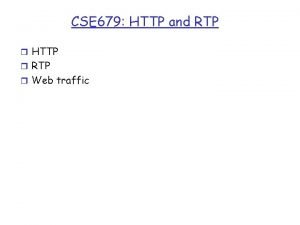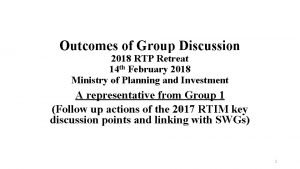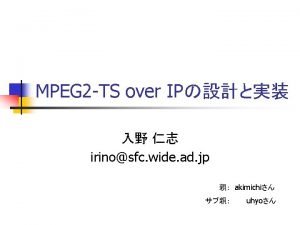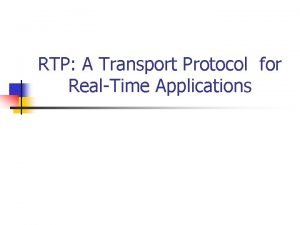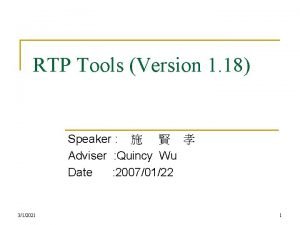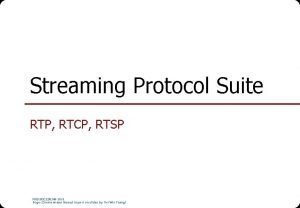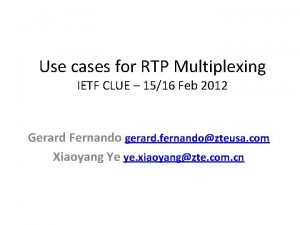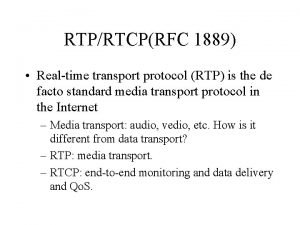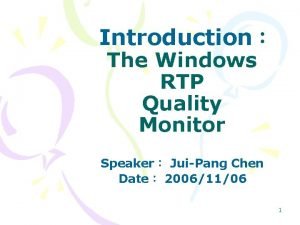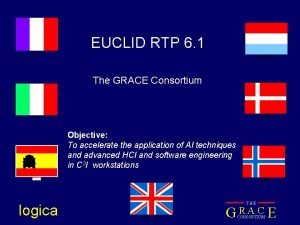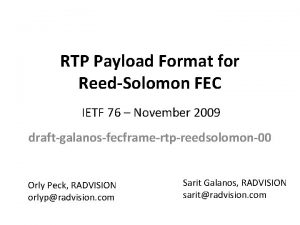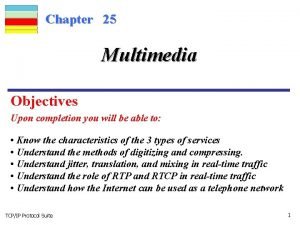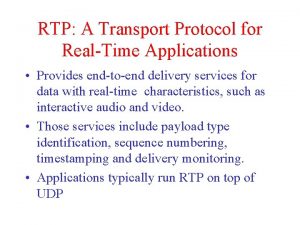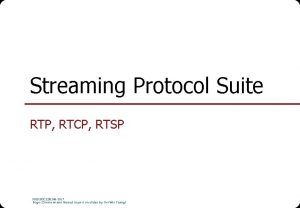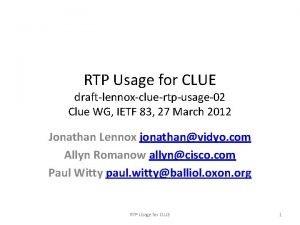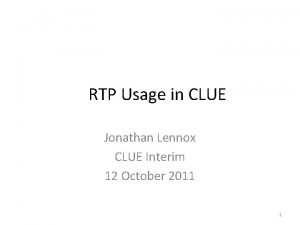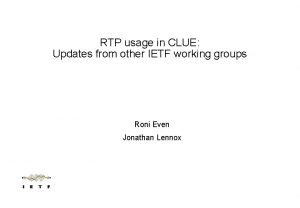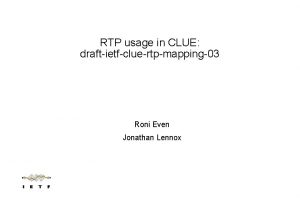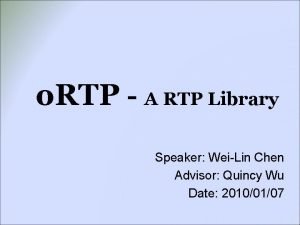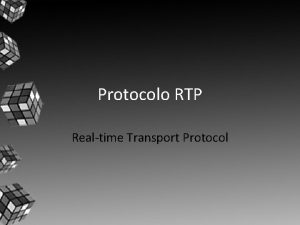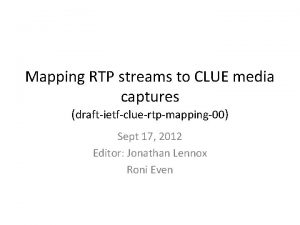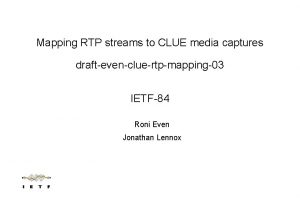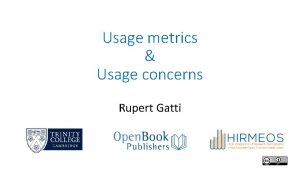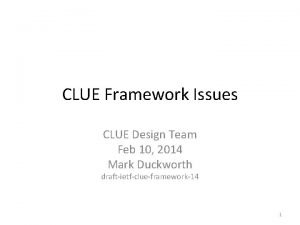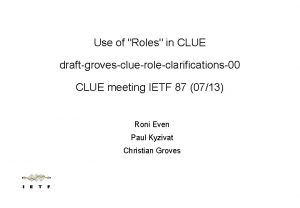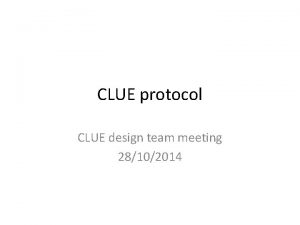RTP Usage for CLUE draftlennoxcluertpusage02 Clue WG Interim
















- Slides: 16

RTP Usage for CLUE draft-lennox-clue-rtp-usage-02 Clue WG Interim – 16 February 2011 Jonathan Lennox jonathan@vidyo. com Allyn Romanow allyn@cisco. com Paul Witty paul. witty@balliol. oxon. org RTP Usage for CLUE 1

RTP Requirements for CLUE • CLUE permits SIP calls to have many media sources – Easily dozens at a time, e. g. for continuous presence in multipoint sessions. – Potentially choosing among hundreds of inputs (for switched or composited captures). – Number of media sources can be asymmetric and dynamic. RTP Usage for CLUE 2

Architectural constraints • Initial offer shouldn’t confuse non-CLUE endpoints. • Signaling messages shouldn’t confuse SIP middleboxes. • Transport flow usage (for NATs, FWs, port consumption on MCUs, etc. ) should be restrained and static. RTP Usage for CLUE 3

Source multiplexing • Send all sources of the same media type over a single RTP session. Camera 1 Screen 1 Camera 2 Screen 2 Camera 3 Screen 3 • Even though these correspond to different CLUE captures. • (Unless you need different transport treatment. ) RTP Usage for CLUE 4

Complications for CLUE • Receiver needs to interpret sources it receives, and correlate them with captures it has requested. • In some cases, CLUE Framework captures map to RTP sources (SSRC), but in many cases they do not. RTP Usage for CLUE 5

Use Case 1: Static Source Choice • Sources are constant over complete session Endpoint RTP Usage for CLUE 6

Use Case 2: Point to Point Finite Sources • Choice from among a small set of sources • Set of sources might change over a session • A source might move between switched captures Endpoint RTP Usage for CLUE 7

Use Case 2: Point to Point Finite Sources • Choice from among a small set of sources • Set of sources might change over a session • A source might move between switched captures Endpoint RTP Usage for CLUE 8

Use Case 3: Multipoint Unbounded Sources • Switched multipoint device: MCU sends sources from any endpoint to any other, switching dynamically. EP MCU EP EP EP RTP Usage for CLUE 9

Mapping sources to captures • A capture might correspond to one or more sources. • A source might be used for one or more captures. • Sources are identified by SSRC, but SSRC is a random number with no further information. RTP Usage for CLUE 10

Need for accurate mappings • Some equipment needs to know source-tocapture mappings before decoding. – Dedicated decoder hardware: one-out-one-in. – Decoder hardware associated with specific displays/speakers. • Receiving mapping information late can mean discarding packets, leading to poor switching times, excess I-Frame requests, etc. RTP Usage for CLUE 11

Need for flexible mappings • Conversely, some equipment can share decoder state as sources move between captures. – E. g. continuous presence screen: 16 recent speakers. • (Details of policy choice not important here. ) – Same source being sent for more than one capture. • Don’t want to require unnecessary I-frames or duplicate transmission. RTP Usage for CLUE 12

Sending mapping outside media • In CLUE messaging – Reliable, but not time-guaranteed. – Depending on how CLUE is sent, might be very heavyweight. • In RTCP SDES – Unreliable; subject to RTCP timing/bandwidth rules. 0 1 2 3 4 5 6 7 8 9 0 1 +-+-+-+-+-+-+-+-+-+-+-+-+-+-+-+-+ | Capture. ID=9 | length=4 | Capture ID : +-+-+-+-+-+-+-+-+-+-+-+-+-+-+-+-+ : | +-+-+-+-+-+-+-+-+ RTP Usage for CLUE 13

Sending capture IDs in media stream • Tag media packets with capture IDs • Advantages: – No latency or possibility of confusion • Disadvantages: – Processing load for switching MCU • Capture IDs are scoped to each hop. – Additional packet overhead: potential bandwidth or MTU issues. RTP Usage for CLUE 14

RTP Header Extension • Can carry capture ID in RFC 5285 header extension a=extmap: 1 urn: ietf: params: rtp-hdrex: clue-capture-id 0 1 2 3 4 5 6 7 8 9 0 1 +-+-+-+-+-+-+-+-+-+-+-+-+-+-+-+-+ | ID=1 | L=3 | capture id | +-+-+-+-+-+-+-+-+-+-+-+-+-+-+-+-+ | capture id | +-+-+-+-+ • Modification could be costly, especially for SRTP (reauthentication required). • RTP header extensions “MUST only be used for data that can safely be ignored by the recipient” – semantics are unclear. (Need SDES as well? ) • Defining this wouldn’t be in scope for CLUE anyway (presumably would be AVTEXT). RTP Usage for CLUE 15

When to send Capture ID • Option 1: always – Disadvantages as mentioned • Option 2: as needed – With I-frames, or for some period of time following a capture ID switch. – Imposes additional state-maintenance requirements on receivers. – May need refresh request AVPF feedback message. • Recommendation: MUST support option 1, MAY negotiate option 2. RTP Usage for CLUE 16

